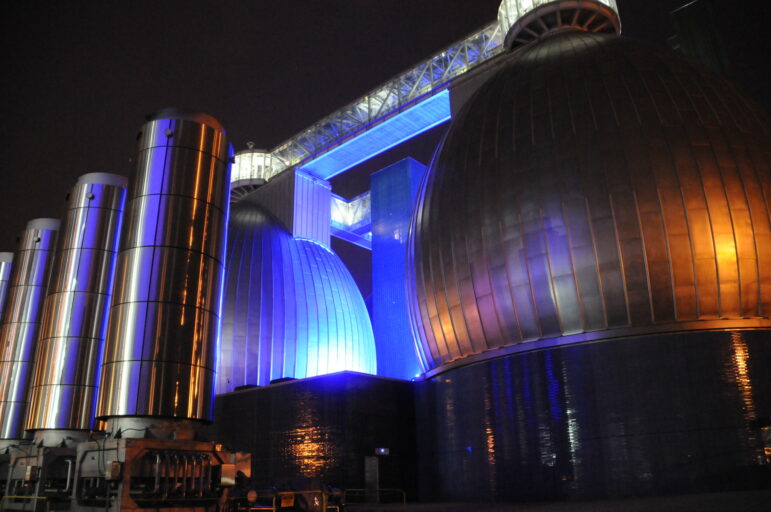“Emissions of methane, a greenhouse gas that is 84-87 times more potent than CO2 as a planet warmer, have actually increased. Methane now comprises 40 percent of New York’s total net greenhouse gases, up from 39 percent in 2019.”

At the end of last year, New York State released its latest annual greenhouse gas inventory, covering the year 2021. The good news was that carbon dioxide emissions went down from 2019, leading to an overall decrease in net greenhouse gases.
But this masks a big problem. Emissions of methane, a greenhouse gas that is 84-87 times more potent than CO2 as a planet warmer, have actually increased. Methane now comprises 40 percent of New York’s total net greenhouse gases, up from 39 percent in 2019.
While a rise of 1.6 percent in New York’s methane emissions from 2019 may not sound like a big increase, astonishingly, these emissions were higher in 2021 than they were in 1990—31 years earlier.
The net increase comes from the oil and gas industry, from the use of fossil fuels to generate electricity, and from decomposing organic wastes: sewage, some landfilled waste (including food waste), and especially agricultural manure (up 10.3 percent).
These increases more than offset decreases in methane emissions from buildings and transportation. For example, the decrease in methane from fuel combustion in residential buildings (such as by replacing gas-fired stoves with electric ones) was outweighed three-to-one by an increase in methane from the organic wastes that New York exported to out-of-state landfills, even as in-state landfill methane also rose slightly.
New York’s methane emissions are heading in the wrong direction and won’t get better without policy changes. Some 155 countries, including the United States, have now signed the Global Methane Pledge to cut methane emissions 30 percent by 2030—a goal considered critical for avoiding catastrophic runaway climate change. Clearly New York is not yet doing its share of the heavy lifting.
So what can it do to cut methane in the next seven years? For one, it needs to focus on decomposing organic wastes, which account for a third of New York’s methane. By putting these wastes in airless tanks called anaerobic digesters (ADs), almost 100 percent of their methane biogases can be captured instead of escaping into the air. And the digesters can produce two useful products. The methane biogas can be used to generate electricity, or it can be upgraded to pipeline-quality renewable natural gas (RNG). And the “digestate” remaining in the ADs after gas capture can be used as compost or other high-quality soil amendments.
When RNG is derived from food waste, dairy manure, and/or wastewater, it is the lowest carbon fuel available today. That is because the amount of greenhouse gases trapped to produce the fuel (as potent methane) is much greater than the greenhouse gases emitted (as CO2) when it is combusted. This is called “net carbon negative” and it’s a big win for the climate. By contrast, fossil natural gas, often obtained by fracking, is not renewable and typically leaks substantial methane in the drilling process.
Because ADs can process a large amount and wide range of organic wastes, and can capture almost 100 percent of their methane, they are a key solution to both our climate change and waste reduction challenges. Community composting can also play a valuable (though more limited) role. Community compost programs can only take fruits, vegetables, and yard wastes, but they could cut methane emissions significantly if the sites are well aerated, and they get citizens engaged. However, larger commercial compost sites emit much more methane than ADs.
The independent NGO Energy Vision published a report in November 2023 calculating that if New York State builds 300 more ADs to process food waste, dairy manure, and wastewater, it could cut its methane emissions 15 percent, bringing the state halfway to the 30 percent methane reduction goal.
These ADs could be built in roughly two to six years, at a total estimated price of $3.4 billion. Much of that would likely come from private capital and from federal clean energy funding and tax credits in the Inflation Reduction Act. The typical payback period for AD projects is two to five years. The biggest bang for the buck comes from building food waste ADs—Energy Vision calculated that just 20 of these, processing approximately 50,000 tons per year apiece, would cut the state’s methane 11.2 percent at a total capital expenditure cost of $1 billion.
Two changes in policy could drive the build-out of AD infrastructure and therefore deserve to be high on the state’s 2024 legislative agenda. One is for the New York to adopt lifecycle carbon accounting for energy sources—measuring each fuel’s emissions from its production, transportation, and consumption rather than just measuring them, as New York currently does, from what comes out of tailpipes or smokestacks.
The other is to pass a Clean Fuel Standard, as has already been done in California, Oregon, and Washington State—an innovative transportation-related program in which high-carbon fuel producers who sell their fuel in the state have to buy credits from low-carbon fuel producers, all at minimal government expense.
With the 2030 methane reduction goal just seven years away, and with one strategy that is affordable and can get us halfway there, it is critical to start now on ADs.
Joanna Underwood is founder and senior advisor to the environmental nonprofit Energy Vision, which researches and promotes strategies necessary for a low-carbon, sustainable future.








